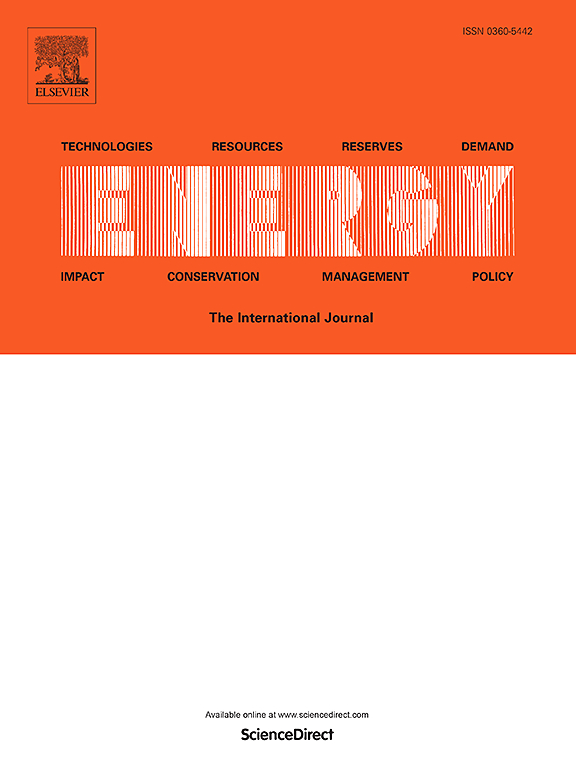Optical diagnostics of ignition and combustion behavior and NOx emission reduction analysis of single-particle excavated waste in MILD-oxy combustion conditions
IF 9
1区 工程技术
Q1 ENERGY & FUELS
引用次数: 0
Abstract
The excavation and incineration of aged landfill waste have been increasingly considered to alleviate landfill space constraints and improve energy recovery efficiency. However, the ignition and flame characteristics of excavated waste (EW) differ from those of conventional municipal solid waste (MSW), potentially leading to higher emissions of NOx and CO2. This study established MILD-oxy combustion conditions for single-particle EW and optical diagnostics were employed to capture instantaneous images of flames. The results show that under N2-O2 atmospheres, only one ignition mode, homogeneous ignition, is observed. Under CO2-O2 atmospheres, three ignition modes are identified: at low oxygen concentration (10 %), heterogeneous ignition predominates with a longer ignition delay time (5–10 s). As the oxygen concentration increases (21 %), homogeneous ignition gradually occurs with a significantly shorter ignition delay time (3–6 s). Further increases in oxygen concentration (30 %) and environmental temperature (1000–1100 °C) reduce the ignition delay time even further, resulting in a hetero-homogeneous ignition mode. This reveals that the high heat capacity of CO2 allows both homogeneous and heterogeneous ignition of EW to occur on the same time scale. Additionally, NOx emissions are significantly lower in CO2-O2 atmospheres than in N2-O2 atmospheres, with the lowest NOx emissions at 10 % oxygen concentration.

轻氧燃烧条件下单颗粒挖掘废弃物点火燃烧行为光学诊断及NOx减排分析
为缓解填埋场空间限制,提高能量回收效率,对填埋场老化垃圾进行挖掘和焚烧处理已被越来越多地考虑。然而,挖掘垃圾(EW)的点火和火焰特性与传统的城市固体废物(MSW)不同,可能导致更高的NOx和CO2排放。本研究建立了单粒子EW的轻度氧燃烧条件,并采用光学诊断方法捕捉火焰的瞬时图像。结果表明,在N2-O2气氛下,只观察到一种点火模式,即均匀点火。在CO2-O2气氛下,确定了三种点火模式:低氧浓度(10%)下,以非均相点火为主,点火延迟时间较长(5 ~ 10 s);随着氧浓度的增加(21%),均匀点火逐渐发生,点火延迟时间明显缩短(3 ~ 6 s)。进一步增加氧气浓度(30%)和环境温度(1000-1100°C)进一步减少点火延迟时间,导致非均匀点火模式。这表明CO2的高热容量允许在同一时间尺度上发生均匀和非均匀的电子束点火。此外,CO2-O2大气中的氮氧化物排放量明显低于N2-O2大气,当氧气浓度为10%时,氮氧化物排放量最低。
本文章由计算机程序翻译,如有差异,请以英文原文为准。
求助全文
约1分钟内获得全文
求助全文
来源期刊

Energy
工程技术-能源与燃料
CiteScore
15.30
自引率
14.40%
发文量
0
审稿时长
14.2 weeks
期刊介绍:
Energy is a multidisciplinary, international journal that publishes research and analysis in the field of energy engineering. Our aim is to become a leading peer-reviewed platform and a trusted source of information for energy-related topics.
The journal covers a range of areas including mechanical engineering, thermal sciences, and energy analysis. We are particularly interested in research on energy modelling, prediction, integrated energy systems, planning, and management.
Additionally, we welcome papers on energy conservation, efficiency, biomass and bioenergy, renewable energy, electricity supply and demand, energy storage, buildings, and economic and policy issues. These topics should align with our broader multidisciplinary focus.
 求助内容:
求助内容: 应助结果提醒方式:
应助结果提醒方式:


